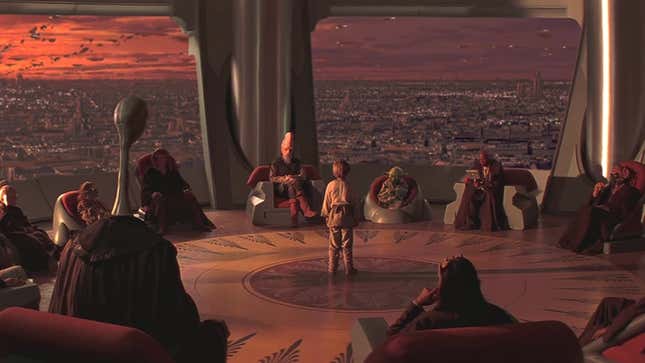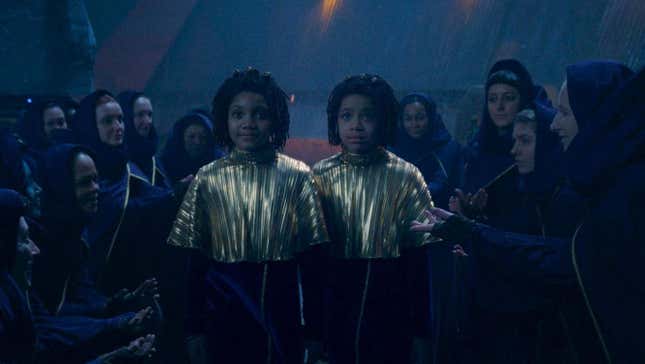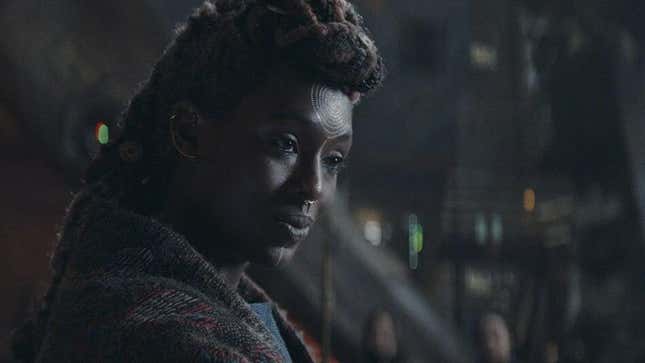There has never been a singular view of the Force in Star Wars. From the original movies introducing us to the framing of light and dark, and Jedi and Sith, to the myriad Force religions that have been woven in and out of Star Wars continuity for generations since, to even how individual Jedi and Sith prescribe differing views among themselves, Star Wars’ spiritual energy has long been a jumble of myriad truths from certain points of views.

But this week’s episode of The Acolyte, “Destiny,” introduced us to a new group of Force wielders in the coven of witches on Brendok that offers a view of what the Force is, and is capable of, that holds a mirror up to everything contemporary canon has told us about a central idea woven throughout the Skywalker saga. And in doing so, their belief system—as far as we’ve seen of it—offers up a way to completely upend what we knew about the spiritual through line that shaped everything from the Star Wars prequels to the sequel trilogy, and the material that has come since that attempts to contextualize what that latter story did: the very nature of what it means for the Force to create life itself.
The Power of One

We’ve always known that the Force could be found in all forms of organic life—that the energy field manipulated by the Jedi and the Sith connected people, plants, animals, every living thing. Life came from the Force, it returned to it in death (and even beyond, if you learned a trick or two, but that’s another story). But the prequel saga introduced into Star Wars’ text a fundamental evolution of that idea—that the Force could manifest life itself, a sentient being created directly by its cosmic will.
The “Chosen One” prophecy of the Jedi pegs this concept as nothing short of miraculous—that the idea of a spiritually conceived being like the young Anakin Skywalker who Qui-Gon Jinn encounters on Tatooine is a once in a multi-generational event. But Jedi interpretation and response to that concept is shaped by their own doctrine. The Jedi Council doesn’t deny Anakin’s origins as a child manifested by the Force, that he had only a mother to carry him to term and no biological father, but they believe that such event is explicitly one manifested by the Light side of the Force: that such a being exists to tip the scales against the enemies of the Jedi, and in defeating those enemies, bring balance.
Viewing Anakin’s birth only through this lens of Jedi prophecy is, in part, what paves the way for his downfall—the Jedi Order Anakin is raised in is thoroughly unprepared to deal with what could happen when a being as strong in the Force as he struggles with their doctrine, or is coerced and manipulated by the Dark Side as he was through Palpatine’s machinations, because it is ultimately blinded to what a being like Anakin represents in response to the Force itself. To the Jedi Order, the Chosen One is a weapon to be wielded against the Sith, against the Dark Side, given to them by the Force—because they did not manifest Anakin’s birth themselves, that his birth is the will of the Force, therefore any attempt to manifest life directly from the Force beyond this is an explicitly dark, unnatural act.
The Power of Two

And to be fair, the Jedi have plenty of reason to believe such an idea, because everything we’re told and shown of the Sith in regards to this concept is, well, dark and unnatural. While no longer canonical material, the 2012 James Luceno novel Darth Plagueis dove deep into the history of Palpatine’s Sith Master in the near-century before the events of the prequel trilogy, and the origins of the “tragedy” that Palpatine briefly recounts to Anakin in Revenge of the Sith.
In that novel, Plagueis and Palpatine’s work exploring the Dark Side is developed as the idea of using the Force to directly manipulate the midi-chlorians in a being’s body—to extend life, to heal wounds, to resurrect the dead. The concept of actually creating new life from the Force to them, while something that Plagueis attempts and fails to do over decades of research, is entirely theoretical. If anything, Darth Plagueis tells us again that attempts to do so are an explicit perversion of the Force’s natural order. While Palpatine and Plagueis’ experiments in midi-chlorian manipulation do not directly create the birth of Anakin Skywalker, the novel frames Anakin’s conception as a response to those experiments by the Force—that the dark nature of what Plagueis was attempting was such an affront to the Force’s very will, a being in direct opposition to those attempts was born in turn.
But again, all of this is non-canonical now. Contemporary Star Wars has yet to explicitly delve into what Plagueis’ power over life was other than the tragedy recounted in Revenge of the Sith, and no material has ever explicitly said that Plagueis, or Palpatine, and their chase to escape death, played a part in Anakin’s creation (there is an oft-misinterpreted page from 2018 canonical comic Darth Vader #25 where Anakin’s own spirit sees a vision of his mother overshadowed by a manipulating Palpatine some take as confirmation he had a direct role in Anakin’s birth—but this was a vision reflecting Anakin’s own doubts and fears, not an explicit depiction, and never to be intended as such, something Vader writer Charles Soule has repeatedly pushed back on).
Instead, what we’ve seen as the Sith interpretation of this idea is very different: not a direct creation of life, but the transference of life from one host to the other, where the body itself is a product of science rather than anything mystical or spiritual. The return of Palpatine from death in the The Rise of Skywalker is described in this way, and has now been explored and re-supported through years of ancillary material and storylines in comics, novels, and series like The Bad Batch or The Mandalorian—attempts to treat the Force as something that can be manipulated by scientific experimentation, whether it’s the transfer of midi-chlorians from a Force-sensitive being into another host, or the creation of clone bodies to act as a new host for a Force-sensitive spirit upon death. We’re also shown, repeatedly, that these attempts to pervert the Force’s connection to life are so evil and twisted that they are almost impossible to do successfully—even when Palpatine manages to revive himself, his body is barely functional, sustained by a throne of medical machinery, and a fraction of the power he had in his first life.
The Power of Many

It is these two mirrored dogmas that have fundamentally shaped our view of this concept across the vast majority of Star Wars fiction: but they are indeed dogmas and doctrines with bias, views, and interpretations that are not exactly definitive. In small parts, Star Wars’ recent history has pushed to explore ideas of the Force and Force-adjacent religions beyond the Jedi/Sith dichotomy, and how they too interpret the link between the Force and the creation of life. In Clone Wars and Ahsoka, for example we have the Nightsisters, whose Force-driven magicks were capable of resurrection in some capacity, but not the direct creation of new life. And now, in The Acolyte, we have Brendok’s coven, who appear to done what, to Jedi and Sith alike, was inconceivable.
“Destiny,” Acolyte’s third episode, is a flashback to the youth of separated twins Osha and Mae Aniseya and their upbringing in the Brendok coven. There, we meet their mothers, Aniseya and Koril, and it’s revealed to the audience in conversation between the two that Osha and Mae were a product of a virgin birth: that Aniseya used her connection to what she refers to as “the Thread” to create the twins, while Koril carried them to term. Osha and Mae are unique—there are no children like them, and are not “normal,” as Koril puts it to Aniseya at one point, but the product of their birth is interpreted in a radically different way to how we we have been presented with it in Star Wars before, through the lens of Jedi and Sith belief.
Aniseya describes their birth as a miracle, but there was no prophecy that intoned what Mae and Osha must represent—and their birth is only framed as “unnatural” or dark when she describes to the coven what other people—pointedly in reference to the Jedi that have made an increasing presence on the planet—would see Osha and Mae’s heritage as. To Aniseya and to the coven, Osha and Mae’s birth is important and meaningful spiritually, but it is also just… a thing that can happen. In their belief system, while clearly rare, everything we’ve been presented so far treats Osha and Mae’s creation as a natural part of their perception of the Force, in line with what they believe about their relationship to how the Force manipulates will and destiny: that these are individual choices and responsibilities, that anyone can pull on the Thread, as Aniseya tells Osha, and take fate into their own hands rather than leaving it up to some cosmic reckoning.

Of course, we don’t have the full picture of what all this actually means—there’s still aspects of this story The Acolyte has deliberately left untold, and what we have seen is in an episode that explicitly asks its audience to embrace the context of what they’re being told as but a single interpretation of events. That in and of itself is already fascinating, but when framing what we’re told of the coven’s use of the Force and Osha and Mae’s birth from it, it becomes an important consideration for Star Wars at large: that everything we thought we knew about this idea, and about the Force, at this point, has been guided by the interpretations of the Jedi and the Sith, of a Light Side, and a Dark.
It’s a democratization of what the Force and be, and who can wield it, that Star Wars has slowly moved back toward in recent years after a period of attempting to define and canonize explicit rules about it—and a move for the better for the galaxy far, far away. In a universe where all these different interpretations of what something as fundamental as the Force is to Star Wars can be allowed to exist, the franchise creates a future full of new perspectives, and with them the potential to do new things within Star Wars’ universe that would otherwise break the “rules” we know of—things aren’t really rules themselves in the first place. That’s how Star Wars canon has always evolved and grown in either of its forms in the first place: that information we previously believed to be the truth can in fact be changed by new context or new perspectives, or change into something else entirely.
What The Acolyte does is just carrying on that legacy—not contradicting, but adding, and reminding us that what has come before has always been from a certain point of view.
Want more io9 news? Check out when to expect the latest Marvel, Star Wars, and Star Trek releases, what’s next for the DC Universe on film and TV, and everything you need to know about the future of Doctor Who.


